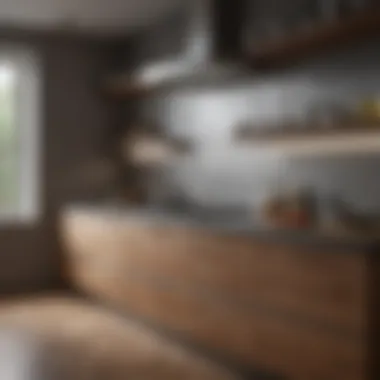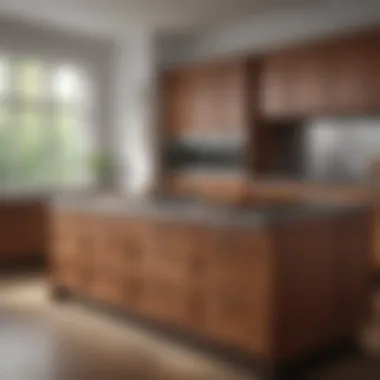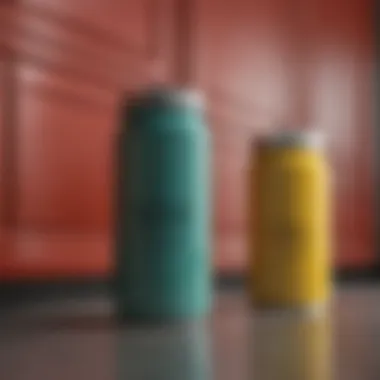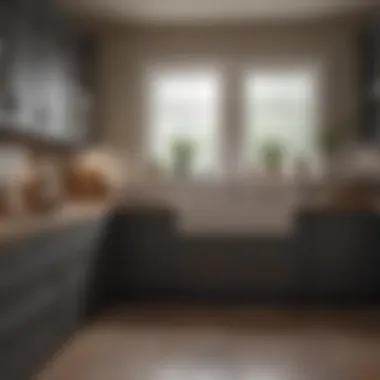Refinishing Kitchen Cabinets: Options and Insights


Intro
Refinishing kitchen cabinets is a practical yet transformative project that can alter the aesthetic and functionality of your kitchen. Homeowners often seek to refresh their spaces without the substantial costs of a complete remodel. Understanding the various options for refinishing can empower individuals to make sound decisions regarding their kitchen's appearance. This article will delve into several refinishing techniques, discussing their advantages and disadvantages, as well as considerations for both DIY enthusiasts and those who may prefer professional assistance.
Design Inspirations
Trending Styles
As design trends evolve, so too do the expectations regarding kitchen aesthetics. A few popular styles that can inspire refinishing projects include:
- Modern Minimalism: Characterized by clean lines and neutral colors, this style often uses matte finishes for cabinets.
- Rustic Charm: This trend embraces natural wood grains, often incorporating distressed or weathered finishes to create a warm, inviting look.
- Industrial Flair: Combining metal and wood finishes, this style brings in a contemporary edge while maintaining functionality.
- Classic Elegance: Traditional cabinet refinishing may involve deep colors, such as navy or forest green, paired with classic hardware.
Each of these styles offers unique opportunities to reimagine a kitchen space without incurring the expenses associated with complete renovations.
Color Palettes
Color plays a crucial role in cabinet refinishing. Selecting the right palette can significantly influence the overall ambiance of the kitchen. Some effective color palettes include:
- Monochromatic Schemes: Using varying shades of a single color can create a sleek and cohesive look. Light grays, whites, and blacks work particularly well.
- Contrasting Combinations: Pairing darker hues with lighter ones can add depth and visual interest. For example, dark navy cabinetry with crisp white countertops.
- Nature-Inspired Tones: Earthy colors like soft greens and browns provide a calming effect, aligning with the growing trend toward biophilic design.
When choosing a color, consider how it will harmonize with existing elements in the kitchen. Lighting conditions should also be taken into account as they can alter how a color appears.
Maintenance and Upkeep
Seasonal Maintenance Checklist
Once refinishing is complete, proper maintenance will keep cabinets looking their best. Here’s a seasonal checklist to consider:
- Spring: Inspect for wear and tear, clean handles and knobs, and consider a light polish.
- Summer: Check for moisture and prevent humidity damage, particularly in hot climates.
- Fall: Reassess the finish and look out for scratches or signs of fading.
- Winter: Ensure proper heating to prevent wood from warping, and clean surfaces to remove any grime from holiday cooking.
Cleaning and Organization Tips
Keeping refinished cabinets in prime condition involves daily and routine maintenance. Here are some practical tips:
- Use non-abrasive cleaners to avoid damaging the finish.
- Regularly organize the contents of the cabinets to avoid overcrowding, which can lead to scratches and dents.
- Apply a fresh coat of sealant if needed, depending on the material and finish of the cabinets.
Important Note: Regular maintenance not only extends the life of your cabinets but also maintains the integrity of the aesthetic refinishing efforts.
Prelude to Kitchen Cabinet Refinishing
Kitchen cabinet refinishing is a pivotal topic for homeowners and design enthusiasts alike. As the kitchen serves as a central hub in most households, the appearance of cabinetry plays a significant role in both functionality and aesthetics. Refinishing offers an opportunity to rejuvenate and modernize kitchen space without the extensive investment that comes with complete replacement.
Refinishing involves updating the surface or finish of a cabinet while maintaining its existing structure. This process can improve the longevity of the cabinets and support better usage of existing resources. Given current economic conditions and growing environmental awareness, many homeowners consider refinishing a sustainable alternative.
Understanding the need for refinishing is essential. It allows individuals to assess if their cabinets have reached a point where cosmetic improvement is necessary. Furthermore, refinishing can be achieved through various methods, each with distinct implications, thus enabling flexibility in choices.
In the upcoming sections, we will explore specific refinishing techniques, benefits of each method, and considerations that can aid in decision-making. The following subsections delve deeper into the motivations behind refinishing and its advantages in comparison to outright replacement.
Preparation Steps for Refinishing
Refinishing kitchen cabinets is not just about applying paint or stain; it begins with a critical phase: preparation. Skipping preparation can lead to unsatisfactory results, affecting both the appearance and durability of the finish. Proper preparation sets the stage for a successful refinishing project. This section outlines the essential steps to effectively prepare your kitchen cabinets, ensuring a smooth refinishing process and optimal results.
Assessing the Condition of Cabinets
Before diving into refinishing, evaluating the current state of your cabinets is crucial. Inspecting for damage, such as scratches, dents, or peeling surfaces, can help you determine the right approach. Not all cabinets require the same treatment. For instance, a minor surface issue might only need sanding or touch-up paint, while deeper flaws may necessitate more intensive repairs.
Consider the construction material of your cabinets. Solid wood often provides better results compared to engineered wood. Check for any signs of water damage or warping. Identifying these factors early allows for targeted actions. Additionally, assess the finish currently on the cabinets. Knowing whether the existing finish is paint, stain, or varnish will influence the preparation methods you choose.


Gathering Required Tools and Materials
Equipping yourself with the right tools is vital for a successful refinishing job. Here’s a concise list of essential items you will need:
- Screwdriver: To remove hardware and doors
- Sandpaper (various grits): For smoothing surfaces
- Clean cloths: To wipe down cabinets after cleaning and sanding
- Paint or stain: Depending on your chosen refinishing method
- Paintbrushes and rollers: For applying the finish
- Drop cloths: To protect floors and countertops
- Cleaning solution: To properly prepare surfaces
Having these items handy reduces downtime and frustration during the process. It is advisable to source high-quality materials, as this will impact the final look and longevity of the finish.
Proper Cleaning Methods
Cleaning the cabinets before starting any refinishing project is a fundamental task. Removing grease, dust, and grime ensures that the new finish adheres properly. Here are steps for effective cleaning:
- Remove Hardware: Take off knobs, pulls, and hinges. This will provide easier access to every surface.
- Dusting: Use a dry cloth or a feather duster to wipe away loose dust from cabinets.
- Washing: Prepare a mild cleaning solution using warm water mixed with a few drops of dish soap. Gently scrub the surfaces with a non-abrasive sponge or cloth. Pay special attention to areas around handles where grease can accumulate.
- Rinsing: After cleaning, dampen a clean cloth with plain water and wipe down the cabinets to remove any soap residue.
- Drying: Allow the cabinets to dry thoroughly before starting the refinishing process. Ensuring all moisture is gone is key to achieving a smooth finish.
Proper preparation is the foundation of successful refinishing. Skipping these steps can lead to unsightly results and wasted materials.
By thoroughly assessing the cabinets, gathering the necessary tools, and employing effective cleaning methods, you set yourself up for a productive refinishing experience. This attention to detail will not only enhance aesthetics but also ensure the durability of the new finish.
Popular Refinishing Techniques
Refinishing kitchen cabinets is a commonly considered option for homeowners looking to enhance the aesthetics of their kitchens. The section on Popular Refinishing Techniques provides essential insights into effective methods for improving the appearance and longevity of cabinets. Refinishing offers a practical solution that often yields superior results compared to full cabinet replacement. Understanding the various techniques available helps individuals make informed choices that align with their design vision and budget.
Painting Kitchen Cabinets
Choosing the Right Paint
Choosing the right paint is a pivotal step when refinishing cabinets. It contributes significantly to the overall outcome of the project. One key characteristic of the paint is its durability against wear and tear. A high-quality paint can withstand daily use, which makes it a resilient choice for kitchen cabinets. It is important to select finishes designed specifically for cabinetry to ensure proper adhesion and longevity.
Paint that contains a semi-gloss or high-gloss finish is often recommended. These finishes not only enhance the visual appeal but also provide a layer of protection against moisture. However, one must consider that certain types of paint may require additional coat layering, which can increase the project time.
Surface Preparation for Painting
Surface preparation for painting is crucial to achieving a smooth and even finish. The primary step involves cleaning and sanding the surfaces to remove any old finishes or residues. A well-prepared surface allows the paint to adhere effectively, which greatly impacts the resulting durability. This characteristic makes thorough preparation essential for successful refinishing.
Failing to adequately prepare the surface might lead to peeling or chipping over time. For this reason, investing time in preparation sets a strong foundation for a successful project. This part of the process may seem tedious, but the difference it makes is evident after painting.
Application Process
The application process of paint is where technique plays a significant role. Using the correct tools, such as foam rollers or high-quality brushes, can aid in achieving an even distribution of paint. Consistency in application contributes heavily to the professional look of the finished product. One key aspect here is to use thin coats of paint and allow adequate drying time between applications. This method results in a smoother finish, minimizing the risks of unsightly drips or uneven surfaces.
Homeowners frequently find that methodical application leads to surprising results. However, some may experience challenges, particularly if they rush this step.
Staining Wood Cabinets
Types of Stains Available
The variety of stains available offers options to suit different styles and preferences. Each stain type can drastically alter the wood's appearance, giving homeowners flexibility in their refinishing projects. Water-based, oil-based, and gel stains are common choices, each with unique characteristics. Water-based stains tend to dry quickly, allowing for faster project completion. On the other hand, oil-based stains can penetrate deeper, giving a richer finish.
The diversity in stain types provides homeowners with choices depending on the desired look and finish. However, it's important to consider that oil-based stains take longer to dry and may perceive stronger odors during application.
Staining Process Overview
The staining process is straightforward but requires careful attention. First, sand the wood to ensure a smooth surface. Next, apply the stain using a clean cloth or brush, working with the grain of the wood. Following application, it is essential to wipe away any excess stain to avoid uneven color.
This basic outline characterizes a typical staining process. Many homeowners achieve impressive results when they take the time to follow these steps closely. However, be mindful of color absorption, as some wood types may react unpredictably to certain stains, potentially altering the anticipated look.
Tips for Even Application
Applying stain evenly is vital for achieving a pleasing finish. One effective tip is to work on smaller sections at a time. This technique helps maintain control and accuracy, providing an even coating throughout. Additionally, using the same cloth for application and wiping off ensures uniformity in tone.
Experimentation can be helpful to find the right method that works for personal style. Nevertheless, uneven application can be a problem for those unfamiliar with the technique. Therefore, practice and patience play key roles in mastering this skill.


Veneering as a Refinishing Option
Understanding Veneering
Veneering involves applying a thin layer of high-quality wood to existing cabinet surfaces. This technique provides the rich look of solid wood without the significant cost or weight. Understanding this option is fundamental for those interested in upscale finishes without complete cabinet replacement. A distinguishing feature of veneering is its ability to significantly enhance aesthetic appeal while maintaining structural integrity.
Veneering provides versatility in design, but careful execution is critical. Poor application can lead to bubbling or lifting, which diminishes the overall effect. Thus, using quality veneers with proper adhesives is vital for success.
Installation Techniques
Different installation techniques exist for veneering, ranging from adhesive applications to using clamps for a robust fit. Each method’s effectiveness varies based on the materials used and the cabinets' underlying structure. Clamping, for instance, ensures a tight bond and prevents air pockets—a common issue in veneering.
While straightforward, these installation techniques can pose challenges for those less experienced. Adequate practice and familiarity with the tools can lead to satisfying results.
Benefits of Veneering
The primary benefits of veneering include cost-effectiveness, ease of application, and aesthetic improvement. By opting for veneering, individuals can achieve a high-end look without the expense associated with fully replacing cabinets. Furthermore, this method allows for a wide range of wood types, patterns, and finishes, providing endless design potential.
However, homeowners must consider the longevity of the veneer compared to solid wood. While generally durable, veneers can be more susceptible to damage under extreme conditions. Nevertheless, when executed correctly, the benefits often outweigh potential drawbacks.
Advanced Refinishing Options
Advanced refinishing options present an opportunity for homeowners and design enthusiasts to elevate their kitchen cabinet aesthetics beyond typical refinishing techniques. Different methods not only impact the visual appeal but also determine the longevity of the finish.
Considering advanced options can offer unique advantages. Techniques such as spraying and using gel stains allow for more efficient application and can achieve finishes that are often more durable and attractive than traditional methods. Evaluating these options carefully can help in making a more informed decision, keeping both practicality and aesthetics in mind.
Spraying vs. Brushing Techniques
When refinishing kitchen cabinets, the choice between spraying and brushing is significant. Spraying often provides a smoother finish with less visible brush strokes. It is particularly beneficial when applying paints or finishes that require an even coat. Many professionals favor this method as it can cover large surfaces quickly. However, it requires careful preparation to avoid overspray, which can lead to a messy workspace.
On the other hand, brushing may allow for greater control, particularly in tight spaces. It can be easier for DIY enthusiasts to manage. However, achieving a flawless finish might require more skill and patience. Weighing the pros and cons of each method is essential before deciding on the right approach for your cabinets.
- Advantages of Spraying:
- Advantages of Brushing:
- Smooth, even finish
- Fast application process
- Good for large areas
- Greater control in detailed areas
- Easier for beginners
- Typically requires less equipment
Refinishing with Gel Stains
Gel stains offer a versatile solution for kitchen cabinet refinishing. Unlike traditional stains, which can be difficult to apply evenly, gel stains provide a thicker consistency that allows for better control during application. This is particularly useful for vertical surfaces, as gel stains tend to stay in place, reducing drips and runs.
The application process for gel stains is straightforward but does require some specific techniques:
- Surface Preparation: Cleaning and lightly sanding the cabinet surface prepare it for better adhesion.
- Application: A brush or cloth is typically used to apply the stain, working it into the wood grain for an even finish.
- Sealant: Once dried, a clear sealant can be applied to protect the stain and enhance durability.
Gel stains can enhance the natural grain of wood cabinets, providing depth and richness that is often desired in kitchen designs.
Professional Refinishing Services
Professional refinishing services offer an important option for homeowners looking to renew their kitchen cabinets. These services are essential for those who prefer to avoid the challenges that often accompany DIY projects. Expert refinishers have the tools, skills, and experience necessary to deliver high-quality results. Moreover, they can handle more complex refinishing techniques that may be beyond the reach of the average homeowner. Choosing a professional can save time and labor, allowing for a more efficient process which may yield superior results.
When to Consider Professional Help
There may be several scenarios when hiring a professional for refinishing cabinets is advisable. One of the most significant factors is the cabinet's condition. If the cabinets show signs of severe damage, such as deep scratches, warping, or significant wear and tear, a professional can assess and recommend the best approach.
Furthermore, if you have limited time or lack confidence in your refinishing skills, professional assistance makes sense. Professionals not only expedite the process but also ensure an outcome that meets high standards.


Choosing a Reputable Contractor
Choosing the right refinishing contractor is critical. The right choice ensures that the project runs smoothly and meets your expectations. Below are key considerations when selecting a contractor for kitchen cabinet refinishing.
Checking Credentials
Checking credentials is a fundamental step in hiring a reliable refinishing contractor. Skilled professionals often hold certifications that reflect their expertise. A reputable contractor should have the necessary licenses, insurance, and warranty coverage. These credentials act as a safety net for you as a homeowner. For instance, those who have formal training in cabinet refinishing will likely adhere to industry standards, resulting in a better finish.
The unique feature of checking credentials is that it filters out unqualified candidates. You not only gain peace of mind but also make a more informed decision. While this can take extra time, it ultimately leads to a more satisfactory refinishing job.
Reading Reviews
Reading reviews provides insight into the contractor's past performance and client satisfaction. Homeowners frequently post their experiences on platforms such as Facebook or Reddit. These reviews can highlight a contractor's strengths and weaknesses, helping others to make a well-informed choice. Consistent positive feedback is a good indicator of quality work and reliability.
The unique aspect of reviews is their ability to offer firsthand experiences without any filter. However, it is important to approach them critically, as some reviews may be biased. Balancing both positive and negative experiences can guide you toward a contractor who suits your needs.
Cost Analysis of Refinishing Options
Understanding the costs associated with refinishing kitchen cabinets is critical for homeowners. Budget considerations often dictate whether to pursue a refinishing project and which method to select. An accurate cost analysis includes evaluating options such as DIY projects versus hiring professionals, as well as estimating material and labor expenses. Knowing the potential costs helps in making informed decisions that can significantly impact both the quality of the finish and the overall look of the kitchen.
DIY vs. Professional Costs
Deciding between a DIY approach or enlisting professional help is a fundamental step in your kitchen cabinet refinishing project.
DIY Refinishing:
- Cost-Effective: Taking on the task yourself can yield savings on labor costs, allowing you to allocate resources toward higher-quality materials or tools.
- Skill Required: However, DIY refinishing requires a certain skill level. Mistakes can lead to additional costs if rework is needed.
- Time Commitment: Completing the project will require significant time, particularly if you are unfamiliar with the process. This should not be underestimated.
- Resource Availability: You need to invest in proper tools which may add to the initial cost.
Professional Refinishing:
- Higher Initial Expense: Hiring a professional usually costs more upfront. However, professionals often deliver quicker and more consistent results.
- Quality Assurance: Experienced contractors can assess the cabinets' condition effectively and suggest suitable refinishing methods that align with your style and needs.
- Time Efficiency: Professionals can complete the job significantly faster due to their expertise and access to specialized tools.
- Long-Term Savings: In some cases, spending more on quality workmanship now can result in less maintenance and problems down the road.
In summary, while DIY can be appealing for its lower costs, factoring in potential hidden expenses and time can make professional services a worthy consideration.
Budgeting for Materials and Labor
To effectively budget for your kitchen cabinet refinishing project, it is essential to break down the costs into materials and labor.
Materials Needed:
- Paint or Stain: Depending on your choice, materials can range significantly in cost based on quality. Understand the coverage needed to estimate properly.
- Primer: Especially for painting, using a quality primer is essential for achieving long-lasting finishes.
- Tools: This may include brushes, rollers, sandpaper, or spray equipment, all contributing to the overall budget.
- Protective Gear: Safety goggles, masks, and gloves are crucial for protection during refinishing.
Labor Costs:
- Hourly Rates: Professional painters and refinishers typically charge hourly or per project. Rates vary based on location and expertise.
- Scope of Work: Understanding the scale of your project is essential. More complex cabinets could incur higher costs due to time and labor required.
"A well-planned budget can prevent unexpected financial strain during your kitchen cabinet refinishing project."
When combining all these elements, a realistic estimate can emerge. Documenting every cost component helps in staying within budget without compromising on quality. This approach ultimately enhances the kitchen’s aesthetics while protecting your investment.
Epilogue
Refinishing kitchen cabinets is more than just a simple home improvement task; it is an investment in both aesthetics and functionality of the kitchen space. The choices you make in this process can significantly affect the look and feel of your kitchen, as well as its overall value. This section will summarize the key elements brought forth in the article, emphasizing their relevance and implications for homeowners or those interested in kitchen design.
Summarizing Key Takeaways
- Understanding Refinishing Options: Homeowners have multiple options to choose from when it comes to refinishing kitchen cabinets. Each method, whether painting or staining, offers unique benefits and results. Options like gel stains and spraying techniques can provide varying finishes that cater to different preferences.
- Cost Considerations: It's crucial to evaluate the cost dynamics. Homeowners should weigh the expenses of DIY refinishing against hiring professionals. Understanding these costs helps in budgeting effectively, making informed choices that align with financial situations.
- Importance of Preparation: One significant factor that determines the success of refinishing is preparation. Assessing the condition of cabinets and properly cleaning them before application cannot be overstated. The result depends greatly on laying a solid foundation before any refinishing technique is applied.
- Professional Help: In some cases, seeking a professional’s opinion or service might be more favorable. Knowing when to opt for outside assistance can save time and ensure a high-quality finish that may be difficult to achieve alone.
"Investing time in understanding the options available for refinishing kitchen cabinets can transform your kitchen without the expense of a full remodel."
- Final Tips for Success: Following best practices through each refinishing method will yield better results. Whether using paint or stain, adhering to recommended application techniques is crucial. Simple tips can help in achieving a professional-looking finish, thereby enhancing the kitchen’s overall appearance.
Final Thoughts on Kitchen Cabinet Refinishing
Kitchen cabinet refinishing encompasses a variety of strategies that can breathe new life into a space. It is essential to approach this project with detailed knowledge and an eye for design. By identifying the current needs of the cabinets, having the right materials, and executing the proper techniques, homeowners can successfully revitalize their kitchens. Moreover, understanding the balance between DIY efforts and professional services can help in achieving one's desired aesthetic without compromising on quality or incurring unnecessary costs. It is ultimately about making informed choices that reflect personal style while ensuring durability and functionality in the kitchen environment.







